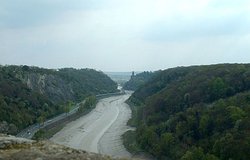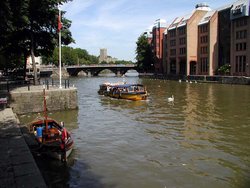River Avon, Bristol
|
|
The River Avon is a river in the south west of England. In its lower reaches the river is navigable and known as the Avon Navigation. Because of a number of other River Avons in England, this river is often also known as the Lower Avon or Bristol Avon.
| Contents |
Course
The Avon rises near Chipping Sodbury in Gloucestershire, runs east and then south through Wiltshire, then turns north-west through Bradford-on-Avon, Bath and Bristol and joins the Severn estuary at Avonmouth near Bristol. For much of its course, it marks the traditional boundary between Somerset and Gloucestershire.
Pulteney_Bridge,_daytime,_from_weir.jpg
In central Bristol, where the river is tidal, it is diverted from its original course onto the "New Cut", a channel dug between 1804 and 1809 at a cost of £600,000. The original course is held at a constant level by lock gates (designed by Brunel) and is known as the Floating Harbour. This gave the port an advantage by enabling shipping to stay afloat rather than grounding when the tide went down. Downstream of central Bristol the river passes through the deep Avon Gorge, spanned by Brunel's Clifton Suspension Bridge.
Navigation
The Avon is continuously navigable from its mouth at Avonmouth as far as Pulteney weir in the centre of the city of Bath. The Kennet and Avon Canal connects with the Avon just below this weir and, together with the Kennet Navigation and the River Thames provides a through route for canal boats from Bristol to London. This navigable stretch can be split into three sections.
From Avonmouth to Bristol through the Avon Gorge, the river is tidal and is navigable by sea going vessels at high tide but drying to a steep sided muddy channel at low tide. It was largely the challenge of navigating this section that sealed the fate of the Floating Harbour as commercial docks, and saw them replaced by docks at Avonmouth.
The second stage of the navigation is through Brunel's locks and the Floating Harbour itself. This unusual dock has a tentacled plan resulting from its origins as the natural river course of the Avon and its tributary, the River Frome (see 'Course' above), and is intimately entwined with Bristol's city centre as few docks are. As a result of this, the Floating Harbour is one of the more successful pieces of dockland regeneration, with much of the dockside now occupied by residential, office and cultural premises, and the water area heavily used by leisure craft.
Upstream of the Floating Harbour is the Avon Navigation proper, which continues upstream for 12 miles as far as Bath. For most of this distance the navigation makes use of the natural river bed, with six locks overcoming a rise of 30 feet. The navigation was constructed between 1724 and 1727, by a company of proprietors and the engineer John Hore of Newbury. It is now administered by British Waterways.
Biodiversity
The river is important for its dragonfly communities, with a strong population of Scarce Chaser (found in only six other areas in England), together with a strong population of White-legged Damselfly. Red-eyed Damselfly is also found.
The river is also important for aquatic plants, including Loddon Pondweed.
Etymology
The name "Avon" comes from the Welsh word afon meaning "river". "River Avon", therefore, literally means "River River".
The County of Avon that existed from 1974 to 1996 covering the Avon valley, including Bristol and Bath, was named after the river.
See also
- Other River Avons
- Photograph of the Clifton Suspension Bridge from Brunel Way
- Photograph of the estuary at Avonmouth
- Rivers of the United Kingdom
External links
- Photos of the River Avon from Bath through Bristol, the New Cut, the Avon Gorge and the estuary at Avonmouth (http://www.steinsky.me.uk/river_avon.php)


